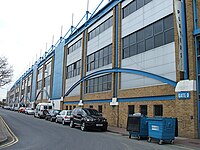Priestfield Stadium

External view of the Medway Stand
|
|
| Full name | MEMS Priestfield Stadium |
|---|---|
| Location | Gillingham, Kent, England |
| Coordinates | 51°23′3.3″N 0°33′38.71″E / 51.384250°N 0.5607528°ECoordinates: 51°23′3.3″N 0°33′38.71″E / 51.384250°N 0.5607528°E |
| Owner | Gillingham F.C. |
| Operator | Gillingham F.C. |
| Capacity | 11,582 |
| Field size | 114 by 75 yards (104.2 m × 68.6 m) |
| Surface | Grass |
| Construction | |
| Built | 1893 |
| Opened | 1893 |
| Tenants | |
|
Gillingham F.C. (1893–present) Brighton & Hove Albion F.C. (1997–99) London Broncos (2012) |
|
Priestfield Stadium (popularly known simply as Priestfield and officially known from 2007 to 2010 as KRBS Priestfield Stadium and from 2011 as MEMS Priestfield Stadium for sponsorship purposes) is a football stadium in Gillingham, Kent. It has been the home of Gillingham Football Club since the club's formation in 1893, and was also the temporary home of Brighton & Hove Albion Football Club for two seasons during the 1990s. The stadium has also hosted women's and youth international matches and from 2013 onwards will play host to London Broncos rugby league matches.
The stadium underwent extensive redevelopment during the late 1990s, which has brought its capacity down from nearly 20,000 to a current figure of 11,582. It has four all-seater stands, all constructed since 1997, although one is only of a temporary nature. There are also conference and banqueting facilities and a nightspot named The Factory. Despite having invested heavily in its current stadium, Gillingham F.C. has plans to relocate to a new stadium.
New Brompton Football Club, the forerunner of Gillingham Football Club, formed in June 1893. At the same time an area of land in Gillingham was acquired by the club's founders, the purchase being funded through an issue of 1,500 £1 shares. Sources differ on whether the stadium was named after the road on which the land stood, Priestfield Road, or whether the road was named after the stadium, although until 1947 the stadium itself was officially named Priestfield Road. A pitch was laid and a pavilion erected, and the first matches at Priestfield were staged on 2 September 1893. New Brompton's reserve team played Grays, followed immediately by the first match for the club's first team, against Woolwich Arsenal's reserves. The admission charge for the two matches was 3d. A newspaper report on the matches noted that the club had recently purchased an additional acre and three-quarters of ground and had accepted a contract for the construction of a stand containing 500 seats. Most spectators stood on terracing, banked earth, or simply along the perimeter of the pitch, as was the case at most football grounds at the time. In order to raise funds to assist with the running of the football club, New Brompton allowed the ground to be used for other events, such as smoking concerts, fêtes, athletics meetings and a ladies' football match. Sheep were allowed to graze on the pitch during the week, a common practice at many grounds at that time. In 1899, a second stand was added along part of the Gordon Road side of the ground, reportedly built by off-duty dock workers in exchange for beer and cigarettes.
...
Wikipedia
